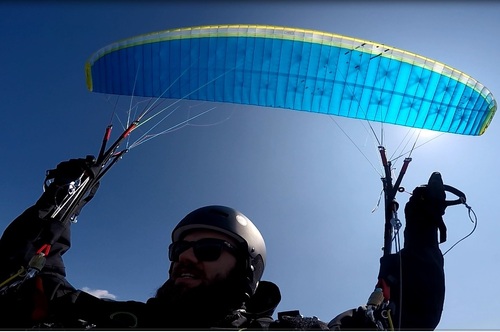NOVA Ion 4M |
|||||||||||||||||||||||||||||||||||||||||||||||||||||||||||||||||||||||||||||||||||||||||||||||||||||||||||||||||||


|
|||||||||||||||||||||||||||||||||||||||||||||||||||||||||||||||||||||||||||||||||||||||||||||||||||||||||||||||||||
Instability rating |
|||||||||||||||||||||||||||||||||||||||||||||||||||||||||||||||||||||||||||||||||||||||||||||||||||||||||||||||||||
|
|||||||||||||||||||||||||||||||||||||||||||||||||||||||||||||||||||||||||||||||||||||||||||||||||||||||||||||||||||
Glider characteristics |
|||||||||||||||||||||||||||||||||||||||||||||||||||||||||||||||||||||||||||||||||||||||||||||||||||||||||||||||||||
|
Launch preparations: average
launch characteristics: balanced, climbs constantly, no guidance necessary, good feedback during inflation, little braking required, slows before zenith, control check simple, low takeoff speed
asymmetric collapse: canopy colllapses at high angle to leading edge, en: EinklapperDynamikGering, total course change 180-270°, (3), moderate course change rate, moderate forward pitching 45-60°, (2), moderate height loss 30-39 m, (2), low sink velocity 10-14 m/s, (1), G-Force < 2,5 G, (1)
Frontal collapse: canopy collapses with high total collapse aera, moderate pitch backwards 30-45°, moderate pitch forwards 30-45°, low dynamics, no course change, (1), recovery usually immediate, symmetric recovery, immediate return to normal airspeed, moderate height loss 30-39 m, (2), low sink velocity 10-14 m/s, (1)
Spiral dives: moderate sink velocity increase, Moderate G-Force 3,5- 4.0 G, (2), Sink velocity after 720° <14 m/s, (1), Moderate maximum sink velocity < 18 m/s, (2), sink velocity increase < 3 m/s on brake release, (1), Course change 90-180° after spiral exit, (1), moderate height loss during recovery 30-60 m, (2)
B-Stall: high force required, moderate pitch backwards 15-30°, moderate pitch forwards 15-30°, unstable sink phase, no tendency to deform, immediate return to normal airspeed, 8-10 m/s, height loss on recovery < 20 m
big ears: simple initiation, stable flight phase, delayed automatic recovery, Vsink unaccelerated 3-3,5 m/s, Vsink accelerated 3,5-4 m/s, Vunaccelerated 0-3 km/h less than trimspeed, Vaccelerated 3-5 km/h faster than trimspeed
Steering behaviour: balanced to agile, 70 cm brake travel range, Noticable brake pressure increase, Late stall point, easily identifiable |
|||||||||||||||||||||||||||||||||||||||||||||||||||||||||||||||||||||||||||||||||||||||||||||||||||||||||||||||||||
Notes |
|||||||||||||||||||||||||||||||||||||||||||||||||||||||||||||||||||||||||||||||||||||||||||||||||||||||||||||||||||
|
Takeoff: The takeoff preparations with the ION4 are average. The thin toplines have a tendency to build loops and knots. The risers are easy to check. After an small impulse the wing climbs with a good directional stability and by itself over the pilot. It is nearly not necessary to stop the canopy over the pilot when the pilot keeps a slow step speed. The controll phase is easy. Flight: The ION 4 has a good and balanced Handling, especially with the brakes. In thermals the ION4 has a small tendency to lever. In turbulent air the ears are a little bit unstable and have a tendency to collapse at the tips without a nervous feeling. It is a good indicator for bad turbulent air and with an active flying style on the brakes, it is easy to keep the glider open. Asymmetric Collapse: In the simulation the ION4 collapse very soft. Without any special pull technic, surface deep collapses are possible. Collapses with a steep kinkline staying in the lower part of the collapse field. At the top of the collapsefield the kinkline remains at 45°. After the deformation the ION4 is turning with a moderate sink rate. The maximum pitch forward in trimmspeed after the collapse is between 55° and 60°. Accelerated is the pitch forward always at around 60°. It is on the border to the next higher SafetyClass 4. The wing opens after 120° completely. The whole Turn is between 180° and maximum 230°. After very big, surface deep collapses the canopy have a tendency to open fast and impulsive without any gain of dynamic. Frontcollapse: It is possible to simulate surface deep collapses with and without speedbar. The canopy collapse soft and with less dynamic. The pitch to front and backside is moderate. The wing opens very fast in the middle. The ears open a bit delayed. When the pilot pull a small collapse the stabilo sometimes open very fast. The result is a slight tendency for horseshoes. This must be respected in Safety-Trainings. The ION4 shows no cravatte tendency. Spiral: The ION4 is easy and in less than 360 ° in the spiral. Due to collapsing tips on the in- and outside during the spiral it was not possible to reach a higher sinkrate than 18m/s. After releasing the brakes the sinkrate does not increase and the glider exits the spiral immediately after releasing . The maximum of turning is around 180 degrees. The maximum centrifugal force is 3.5 G. Even with a fixation of the body weight on the inside of the spiral the ION4 exits the spiral by itself. . B-Stall: The initiating force is normal. As soon as the glider fells in the B-Stall, the B-risers should not be pulled deeper. If you pull the B-Risers to maximum the glider starts getting nervous. It is not easy anymore to hold the B-Stall. Even if the gliders starts getting really nervous, there is no tendency for rosettes or cravats. In calm descent phase, the sink rate is around 9 m/s. BigEars: Simple and effective. Even with big ears without accelerator the ION4 shows a slight increase in speed compared to the Trimmspeed. Stall: The ION4 shows a free brakeline travel of 10 cm and a symmetric brakeline travel of about 70 cm. The brake pressure increases progressively and gets harder on the way to stall. The stall announcement is significant due to a bending of the canopy. The brakepressure shows the stall slightly delayed and less intensively. The announcement of the asymmetric stall is good. |
|||||||||||||||||||||||||||||||||||||||||||||||||||||||||||||||||||||||||||||||||||||||||||||||||||||||||||||||||||
Rating |
|||||||||||||||||||||||||||||||||||||||||||||||||||||||||||||||||||||||||||||||||||||||||||||||||||||||||||||||||||
|
Safety class 3 This class of paraglider react moderately to one or more of the following manoeuvres: frontal collapse, asymmetric collapse or spiral dive.Moderately means that the above manoeuvres result in dynamic reactions from the glider and/or large height losses. Good piloting skills which need to be regularly practised, together with good personal reaction times which are above basic training levels are required to safely fly this class of gliders. Skill and experience levels greater than those attained in basic training are required to safely recover from the above manoeuvres. Emergency descent manoeuvres, in particular spiral dives may require advanced recovery skills. Additional training such as regular ground handling or SIV training is recommended. |
|||||||||||||||||||||||||||||||||||||||||||||||||||||||||||||||||||||||||||||||||||||||||||||||||||||||||||||||||||

